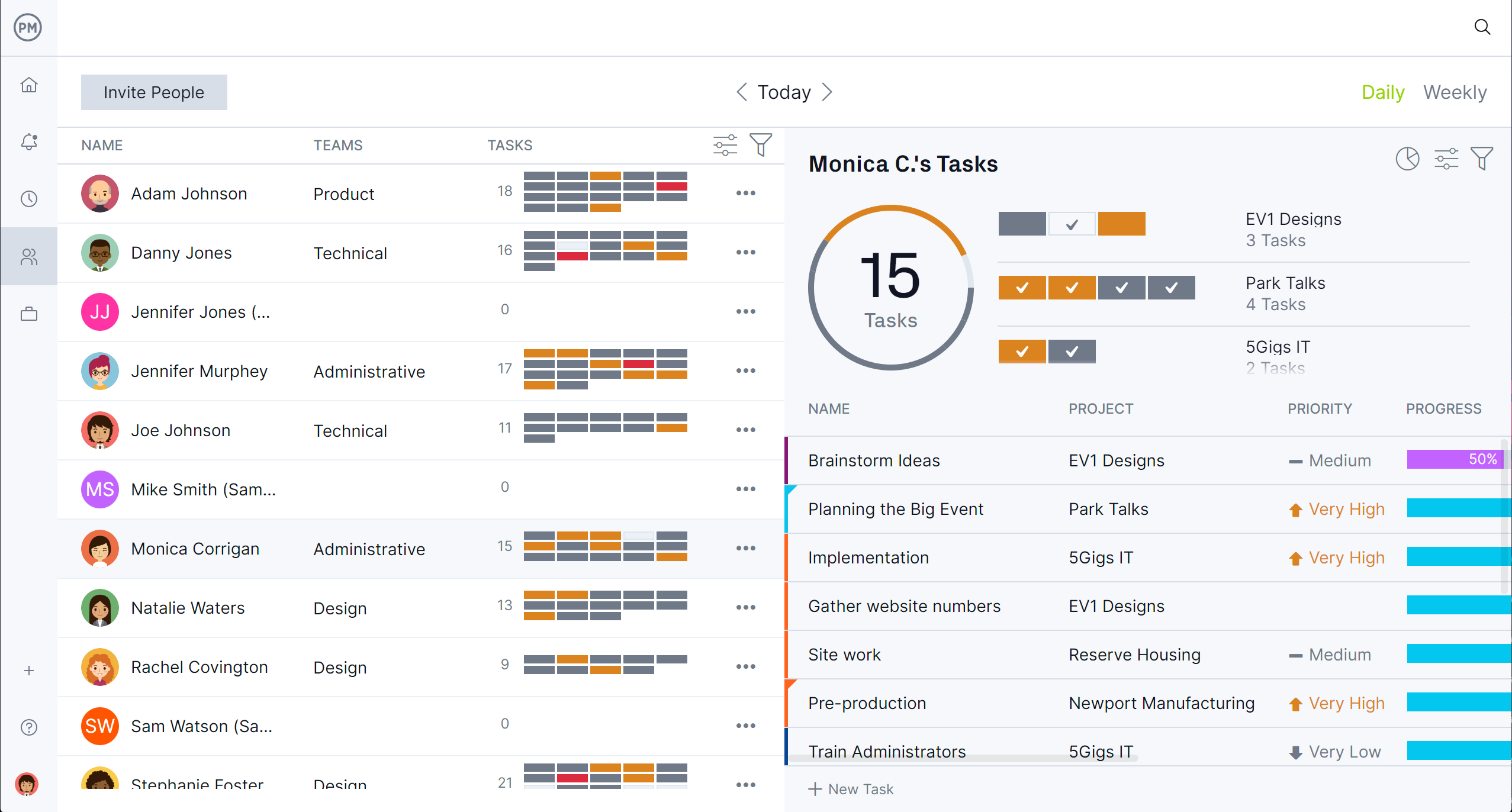Project scheduling techniques are essential tools for organizing, planning and managing tasks efficiently. They help project managers estimate timelines, allocate resources and track progress throughout the project life cycle. Without reliable scheduling techniques, it’s easy for deadlines to slip and budgets to spiral.
Before we get into project scheduling techniques, it’s important to understand the best tools to implement them. While we’ll offer free templates to get a handle on these techniques, they’re not recommended for scheduling projects.
Instead of using static documents like templates that need to be manually updated and are poor collaboration platforms, it’s better to upgrade to project management software. For example, ProjectManager is award-winning project management software with robust Gantt charts that have a comprehensive, visual timeline that supports core scheduling principles like task sequencing, dependencies, milestones and critical path analysis.
Our Gantt charts allow project managers to map out the entire workflow, set start and end dates and adjust timelines as needed with drag-and-drop ease. It also integrates seamlessly with ProjectManager’s resource, cost and tracking tools, making it ideal for applying scheduling techniques such as critical path method (CPM), workload balancing and schedule baselining—all in a centralized, real-time environment. Get started with ProjectManager today for free.
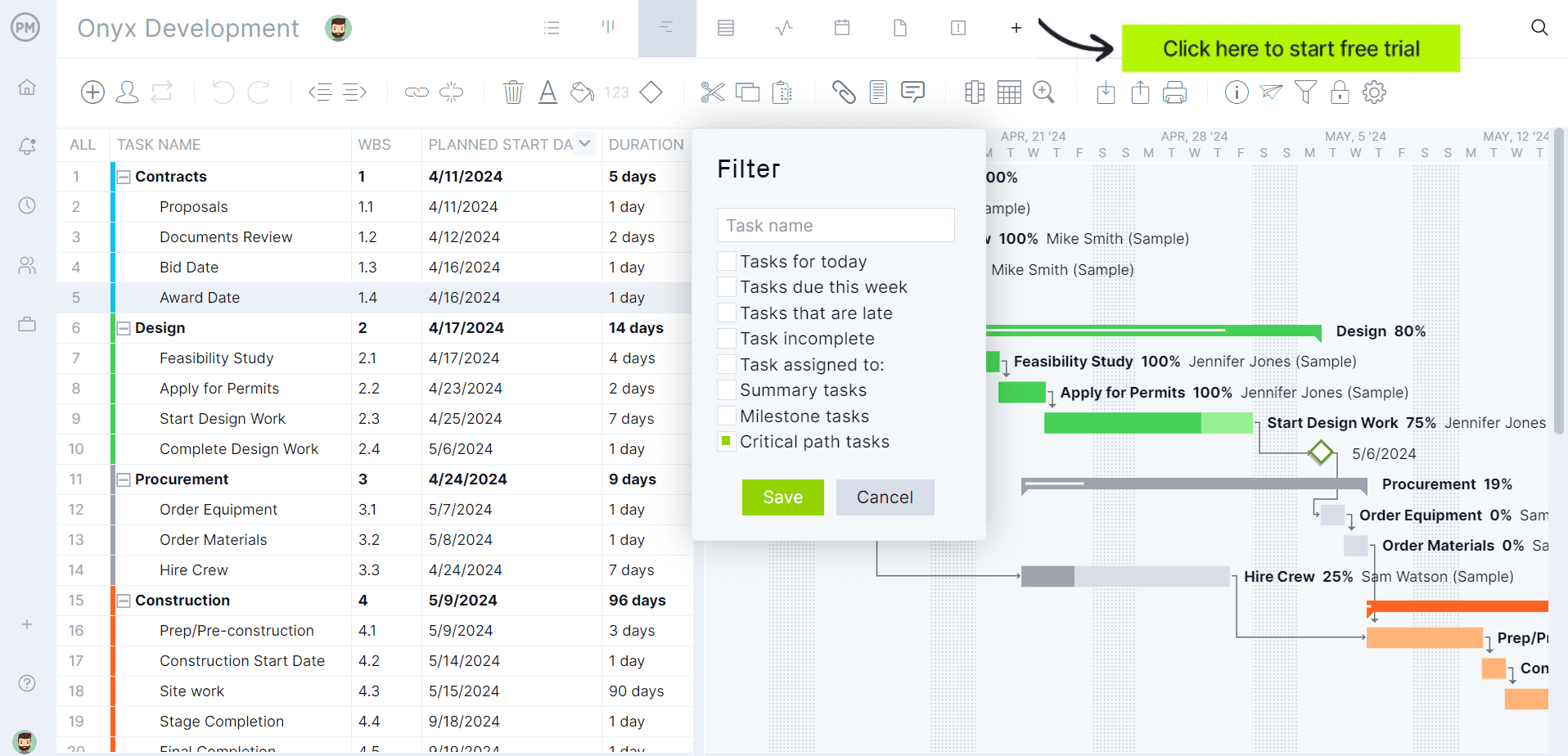

Whether you’re managing construction, IT or event planning, applying the right technique keeps projects on time and within scope. In this guide, we’ll cover 10 top project scheduling techniques to help you make better planning decisions and improve project success rates.
1. Critical Path Method (CPM)
The critical path method (CPM) is a project scheduling technique that identifies the longest sequence of dependent tasks. It uses a network diagram and mathematical calculations to estimate the total duration of a project. By determining the critical path, project managers can identify which tasks cannot be delayed without affecting the project deadline. CPM helps highlight float time for non-critical tasks, making it easier to prioritize and reallocate resources when needed.
When to Use This Project Scheduling Technique?
CPM is widely used in industries like construction, engineering and software development, where task dependencies and deadlines are critical. This project scheduling technique is most useful in large-scale projects involving multiple activities with interrelated timelines. It’s ideal when you need to manage complex workflows, optimize timelines or analyze the impact of delays. CPM is also effective during project planning and monitoring stages, where detailed time estimates and schedule adjustments are frequently needed.
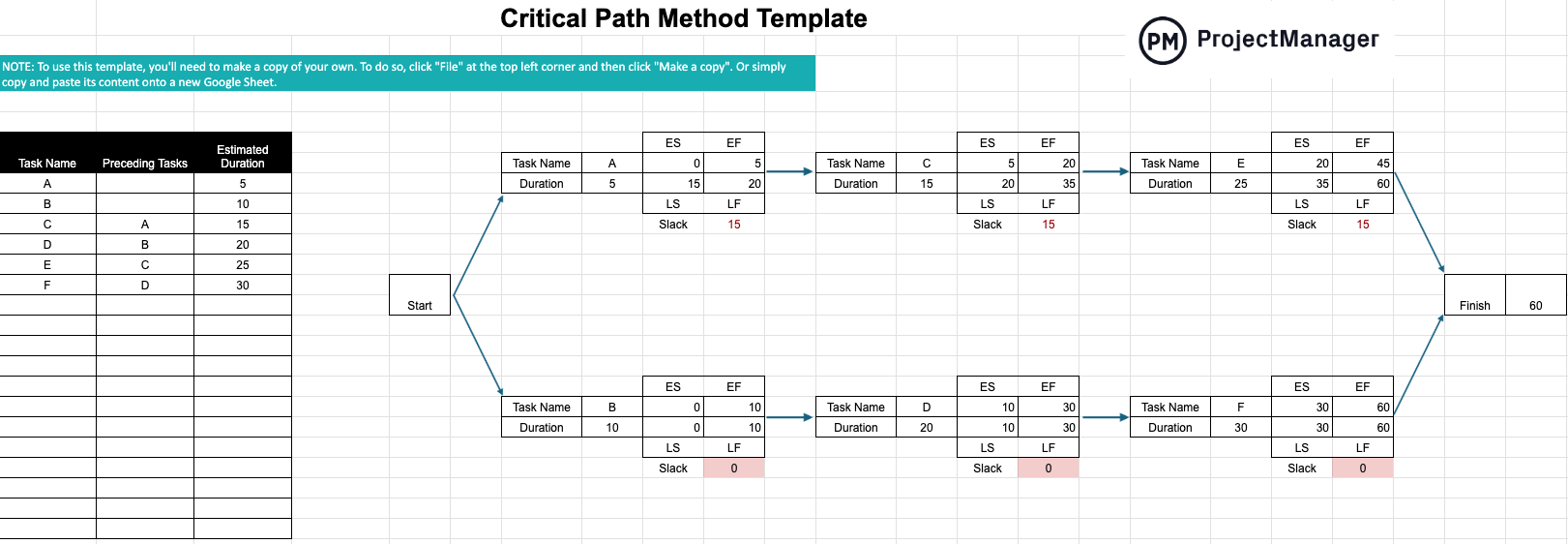

Benefits of This Project Scheduling Technique
The critical path method offers several advantages that help project managers stay organized and on schedule. Below are some key benefits of using this project scheduling technique and how each contributes to more effective project management.
- Helps Prioritize Tasks: CPM highlights which tasks are critical and which have float time, allowing project managers to focus efforts where delays would affect the overall timeline. This clarity improves decision-making and ensures key milestones receive proper attention throughout execution.
- Facilitates Resource Scheduling: CPM supports more efficient resource allocation by identifying task dependencies and durations. It allows project managers to assign team members, equipment and materials based on when they’re needed most, reducing idle time and improving productivity across the board.
- Helps Accurately Estimate the Duration of Projects Before They Start: CPM uses network diagrams and time estimates to calculate the total project duration. This mathematical approach allows for precise scheduling, enabling better forecasting and helping stakeholders set realistic expectations for completion dates and deliverable timelines.
Disadvantages of This Project Scheduling Technique
While the critical path method is a valuable project scheduling technique, it has its limitations. Below are some common challenges associated with CPM and how these drawbacks can affect project planning and execution.
- Mathematical Calculations Can Be Hard to Grasp: CPM requires familiarity with network logic and formulas, which can be difficult for some team members. Misunderstandings or calculation errors can lead to incorrect timelines, poor planning and confusion about task priorities or resource assignments.
- CPM Diagrams Can Become Overly Complex: In large projects, the number of tasks and dependencies can make the network diagram overwhelming. Managing updates or analyzing changes becomes time-consuming, especially if the project undergoes frequent adjustments or has unclear task relationships.
- Effectiveness Depends on Accurate Inputs: CPM’s reliability hinges on the accuracy of task durations and dependencies. If initial data is flawed or overly optimistic, the resulting schedule may be misleading, causing issues with deadlines, budgets and stakeholder trust down the line.
2. Program Evaluation and Review Technique (PERT)
The program evaluation and review technique (PERT) is a project scheduling method that helps estimate a project’s duration by analyzing the time required to complete each task. It uses a network diagram and mathematical calculations based on optimistic, pessimistic and most likely time estimates. PERT is designed to deal with uncertainty in project timelines and is especially useful in planning and analyzing the time required for tasks with variable durations. It helps improve forecasting and risk assessment in project planning.
When to Use This Project Scheduling Technique?
PERT is most commonly used in research, development and engineering projects where task durations are uncertain or variable. This project scheduling technique is ideal for complex, non-repetitive projects in industries like aerospace, defense and technology. It’s especially valuable when you need to forecast project timelines early, even when data is limited or unpredictable. PERT is also helpful during feasibility studies or when project managers want to analyze how different time scenarios affect overall project completion dates.


Benefits of This Project Scheduling Technique
PERT offers a flexible scheduling method ideal for projects with unpredictable elements. Factoring in time variability and focusing on task sequences helps project managers better anticipate risks and plan around uncertainty.
- Attempts to Provide a Realistic Time Estimation for Tasks: PERT uses three time estimates—optimistic, pessimistic and most likely—to calculate a weighted average. This provides a more nuanced and realistic forecast than single-point estimates, especially in complex or research-based projects.
- Ideal for Projects with Uncertain Conditions: Because it embraces variability, PERT is well-suited for projects with undefined scopes, evolving requirements or new technologies. It allows teams to prepare for delays and better manage scheduling risks from the outset.
- Helps Identify Task Dependencies and Task Sequences: PERT charts visually map task relationships and dependencies to help managers spot which tasks influence overall project duration and support smarter sequencing and prioritization decisions.
Disadvantages of This Project Scheduling Technique
While PERT helps with planning under uncertainty, it has limitations in practical execution. It requires manual updates, offers limited real-time control and relies heavily on estimators’ assumptions, which can weaken scheduling accuracy.
- Time Estimations Are Subjective: PERT depends on team members’ ability to guess best-case and worst-case durations. If these estimates are unrealistic or biased, the schedule becomes unreliable and can misguide planning decisions.
- PERT Charts Need to Be Manually Updated: Unlike dynamic scheduling tools, PERT diagrams must be revised manually when task durations change or new dependencies arise, making the process time-consuming in active projects.
- Not Ideal for Project Monitoring and Control: PERT is more of a planning tool than a tracking system. It lacks mechanisms for real-time updates, progress tracking or integration with cost and resource data, limiting its usefulness during execution.
3. Fast Tracking
Fast tracking is a schedule compression technique used when a project falls behind and corrective actions are needed to meet deadlines. It involves performing tasks in parallel that were originally planned to be sequential. While it doesn’t reduce the scope of work, it helps recover lost time by overlapping activities wherever possible. This technique can accelerate project timelines, but it increases the risk of rework and demands strong coordination to avoid conflicts or quality issues.
When to Use This Project Scheduling Technique?
Fast tracking is commonly used in industries with tight deadlines, such as construction, software development and event planning. It’s especially helpful when projects are delayed but the final delivery date must remain unchanged. It suits projects with clearly defined dependencies and teams that can handle overlapping tasks efficiently. Fast tracking is also useful during design-build phases or product launches, where compressing the schedule without cutting scope is critical for meeting regulatory, seasonal or market-driven deadlines.
Below is a fast-tracking example of a residential construction project. Each bar represents a task that must be completed. One task must finish before the rest can begin.


To fast-track the project, tasks must be executed in parallel. This is possible only for tasks that don’t have a dependency, such as wood framing or sheathing installation. However, tasks like roofing work cannot be fast-tracked, as a roof cannot be put on a structure without walls. The image below represents the fast-tracked project with shorter task durations on tasks when possible.
Benefits of This Project Scheduling Technique
Fast tracking is a popular choice for accelerating schedules when time is tight. It helps reduce project duration without increasing resources or changing scope. Below are three key benefits of using this project scheduling technique.
- Accelerates Project Delivery: Fast tracking shortens timelines by overlapping dependent tasks. Instead of waiting for one task to finish before starting another, teams work in parallel, helping the project finish faster while keeping the full scope intact.
- Avoids Overtime Costs: Rather than extending work hours, fast tracking compresses the schedule through smarter sequencing. This minimizes the need for overtime or weekend labor, helping reduce additional payroll expenses while catching up on delays.
- No Additional Budget Needed Initially: Because fast tracking rearranges task order without adding staff or scope, it often doesn’t require an immediate increase in budget. It’s a time-saving option that can be implemented quickly using existing team capacity.
Disadvantages of This Project Scheduling Technique
While fast-tracking helps speed up projects, it has trade-offs that can affect quality, resources and overall coordination. Here are some common drawbacks associated with this technique.
- Increases Risk of Rework: Overlapping tasks can lead to rework if earlier tasks are revised after their successors have already started. This adds unexpected delays and costs, potentially canceling the original time savings.
- May Strain Resources: Fast tracking can overload teams or equipment by requiring multiple activities to run simultaneously. Without careful resource planning, it may result in burnout, bottlenecks or unproductive downtime.
- Not Suitable for All Tasks: Some tasks have hard dependencies and can’t be performed in parallel. Trying to fast-track these may cause confusion, safety risks or compliance issues that harm project execution.
4. Project Crashing
Project crashing is a schedule compression technique used when a project is delayed and immediate corrective action is required. It involves allocating additional resources—such as labor, equipment, or budget—to tasks on the critical path to reduce their duration. While this method speeds up project completion, it typically increases project costs. Crashing is often used when deadlines are non-negotiable, and other options like fast tracking are not feasible. It requires careful analysis to ensure cost trade-offs are justified.
When to Use This Project Scheduling Technique?
Project crashing is typically used in deadline-driven industries such as construction, engineering, event planning and manufacturing. It’s most useful when a project has fallen behind schedule and must meet a fixed deadline due to contractual obligations, regulatory requirements or financial penalties. Crashing is ideal for projects with budget flexibility, clearly defined critical paths and tasks that can benefit from extra labor or resources. It should be considered when speed is more important than maintaining the original cost baseline.
Benefits of This Project Scheduling Technique
Project crashing can be a useful method to recover lost time. It allows teams to meet tight deadlines without changing project scope, especially when schedule is a higher priority than cost.
- Recovers Delayed Schedules Quickly: Crashing shortens the overall project duration by adding resources to critical path tasks. It’s particularly effective when deadlines are at risk and no float remains, allowing project teams to regain lost time without reducing the scope of work.
- Maintains Project Scope: Unlike other time-saving strategies that cut deliverables, crashing keeps the full scope intact. Teams can meet fixed deadlines while maintaining all project requirements, making it ideal for high-visibility or regulated projects where scope reduction would compromise quality or contractual compliance.
- Protects Against Late Penalties: When delays trigger financial penalties, legal consequences, or client dissatisfaction, crashing becomes a useful tool. By accelerating critical tasks, teams can avoid costly overruns, fulfill contractual deadlines, and preserve client relationships without altering scope or sacrificing quality deliverables.
Disadvantages of This Project Scheduling Technique
While project crashing can save time, it has trade-offs. The method often increases costs, puts pressure on resources and is only useful for tasks on the critical path.
- Increases Project Costs Significantly: Crashing often requires additional labor, expedited materials, or specialized equipment to reduce task durations. These accelerated efforts significantly increase the project’s overall cost, making crashing a financially intensive option that should only be used when the deadline justifies the extra investment.
- Can Lead to Team Burnout: Overloading existing team members or rapidly onboarding new staff to meet compressed timelines can lead to burnout, confusion or communication issues. If not properly managed, these pressures may reduce productivity, lower morale and negatively affect long-term team performance.
- Not Always Effective on All Tasks: Project crashing only impacts tasks on the critical path. Applying it to non-critical activities doesn’t reduce the project duration and wastes resources. Therefore, it must be applied selectively and strategically to be cost-effective and schedule-relevant.
5. Milestone Charts
Milestone charts are visual project scheduling tools that highlight key events or deliverables along a timeline. Unlike detailed Gantt charts, they simplify complex schedules by focusing only on major checkpoints. This makes them ideal for presenting project progress to stakeholders or executives who need a high-level overview. Milestone charts don’t show task durations or dependencies but offer clarity by tracking critical phases, approvals and deadlines that define overall project progress.
When to Use This Project Scheduling Technique?
Milestone charts are best used in projects where stakeholders need quick, high-level updates. They’re common in industries like construction, product development, and consulting, especially when executive reporting or client presentations are involved. This technique is useful during the early planning phase, for phase-gate reviews, or to track major deliverables in long-term projects. It’s ideal when full task-level detail is unnecessary, but visibility into major deadlines is critical.
In the below milestone chart example, each diamond symbol represents a milestone, and the black lines represent the task duration. Regular updates to the chart provide an easy way to communicate with stakeholders as progress is made.
Benefits of This Project Scheduling Technique
Milestone charts offer a clean, simplified view of project progress. They’re especially helpful when reporting to executives or clients who need clarity without the clutter of task-level details.
- Simplifies Complex Project Timelines: Milestone charts focus only on major events, helping teams and stakeholders understand project progress at a glance without diving into every task or dependency. This streamlines communication and reduces confusion in complex or large-scale projects.
- Improves Stakeholder Communication: These charts are ideal for status reporting. Their simplicity makes it easy for non-technical stakeholders to track deadlines and phase completions, enabling clearer conversations around project expectations, timing and progress.
- Helps Track Key Deliverables: Milestone charts keep attention on important goals, approvals and deadlines. They’re useful for managing contracts, product launches or gated reviews where meeting specific milestones is critical to project success or payment schedules.
Disadvantages of This Project Scheduling Technique
Despite their clarity, milestone charts have limitations. They don’t show how tasks connect, how long they take or what happens between checkpoints—so they’re best used alongside more detailed scheduling tools.
- Lacks Task-Level Detail: Milestone charts don’t display individual tasks, durations or dependencies. That makes them ineffective for managing daily project work, assigning resources, or tracking incremental progress between major deliverables.
- Not Suitable for Complex Execution: While useful for reporting, milestone charts can’t guide detailed scheduling decisions. Without visibility into task sequences or resource needs, they can’t support day-to-day project management or execution planning.
- Can Oversimplify Project Status: By omitting task-level data, milestone charts may give a false sense of progress. A milestone might appear “on track” even if the tasks leading to it are delayed or at risk.
6. Gantt Charts
A Gantt chart is one of the most powerful and widely used tools in project scheduling. It provides a visual timeline of tasks, showing their start and end dates, durations, and progress. Gantt charts allow project managers to link task dependencies, so if one task is delayed, related tasks shift accordingly. They can also identify the critical path, helping teams focus on the activities that directly affect the project’s end date.
In addition to scheduling, Gantt charts support resource management by assigning team members or equipment to specific tasks. Many modern Gantt chart tools also track costs, monitor task progress in real time and adjust timelines based on changes. This makes it possible to integrate time, scope, cost, and resource data into a single visual interface. The result is a smarter, more centralized way to manage complex projects from planning through execution.
When to Use This Project Scheduling Technique?
Gantt charts are ideal for projects with many tasks, dependencies, and deadlines. They’re commonly used in industries like construction, IT, product development, and marketing. This technique is especially useful for managing cross-functional teams, coordinating resources, and tracking progress across multiple workstreams. Use Gantt charts when visual clarity, timeline accuracy, and detailed planning are essential—particularly in long-term or phased projects that require transparency, frequent reporting, and adaptive rescheduling to keep all stakeholders aligned.
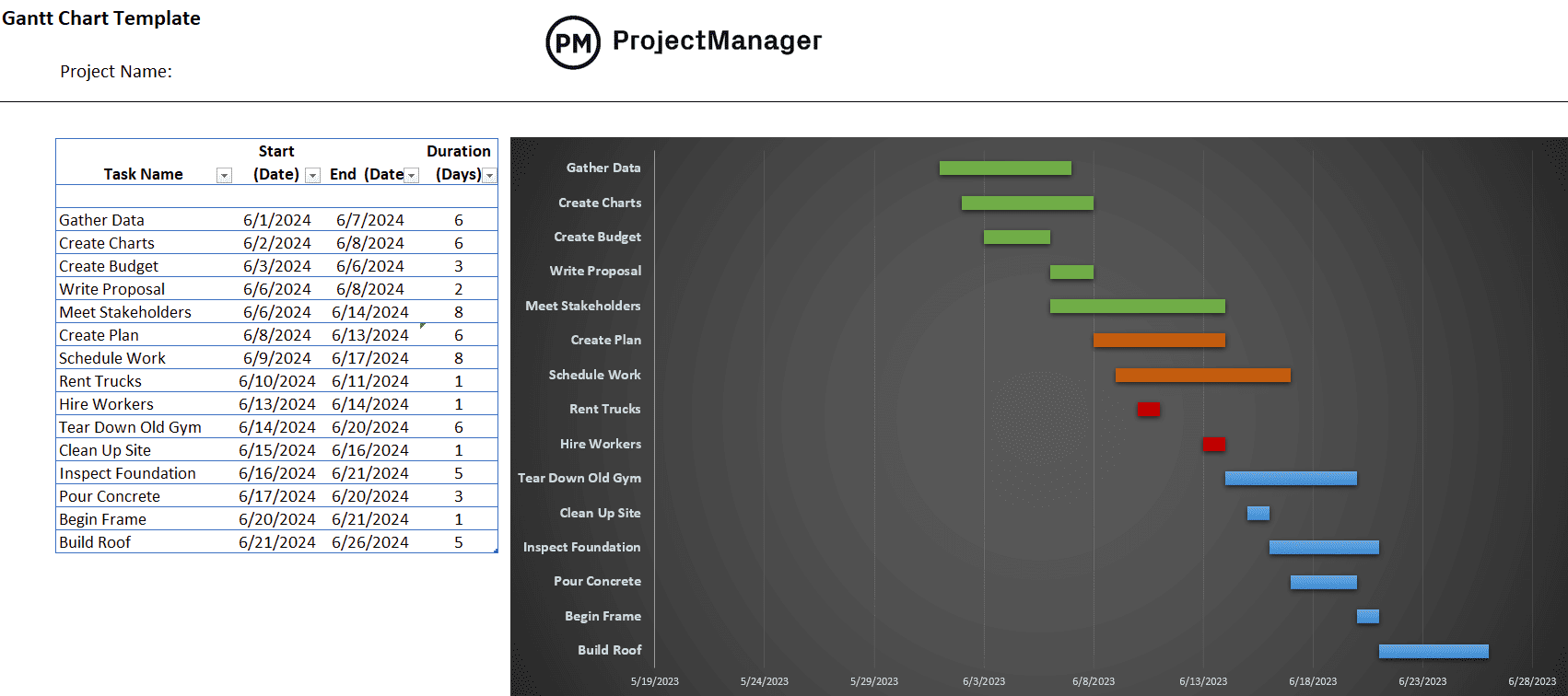

Benefits of This Project Scheduling Technique
Gantt charts are effective because they centralize planning elements in one view. They allow project managers to visualize progress, adjust in real time and communicate clearly with all stakeholders.
- Connects Task Dependencies Visually: Gantt charts clearly show how tasks are linked, helping teams understand which activities must be completed before others begin. This improves sequencing, prevents bottlenecks and enables better planning of start and end dates.
- Monitors Progress in Real Time: By updating task bars as work is completed, Gantt charts offer a live view of project progress. This helps managers spot delays quickly and make informed decisions to get back on schedule.
- Combines Scope, Time and Resources: Modern Gantt tools integrate deadlines, assigned team members, budgets and milestones all in one chart. This unified view makes it easier to manage the entire project efficiently without switching between multiple tools.
Disadvantages of This Project Scheduling Technique
While Gantt charts are powerful scheduling tools, they can become overly complex in large projects. Their visual clarity can diminish as task volume increases, and they require consistent updates to remain accurate and useful for ongoing project execution.
- Can Become Cluttered in Large Projects: With too many tasks and dependencies, a Gantt chart can turn into a tangled web that’s hard to read. This limits its effectiveness in programs with hundreds of activities or frequent task changes.
- Requires Frequent Manual Updates: Without automation, Gantt charts need regular updating to reflect schedule changes, resource shifts or progress. If not maintained properly, they become outdated quickly and can mislead stakeholders.
- Lacks Detail for Day-to-Day Execution: While good for big-picture planning, Gantt charts don’t always show task-level nuances, such as time spent, communication or small blockers. This makes them insufficient as a standalone tool for managing execution in complex, fast-moving projects.
7. Precedence Diagramming Method (PDM)
The precedence diagramming method (PDM) is a visual scheduling technique used in project management to represent task relationships. It shows the logical sequence of activities using nodes and arrows, where each node is a task and arrows indicate dependencies. PDM supports four dependency types: finish-to-start, start-to-start, finish-to-finish and start-to-finish. This allows project managers to build accurate, flexible project schedules and identify the critical path. PDM is widely supported in modern scheduling tools like Gantt charts.
When to Use This Project Scheduling Technique?
PDM is best used in complex projects where task relationships must be clearly defined. It’s widely applied in construction, engineering, IT, and manufacturing. This method is especially useful in projects with overlapping or interdependent activities that require accurate sequencing. Use PDM when multiple dependency types must be managed or when critical path identification is essential for timeline control. It’s ideal for teams using scheduling software and working with strict deadlines, scope requirements or formal project methodologies.
Benefits of This Project Scheduling Technique
PDM helps create detailed, logic-based schedules that improve accuracy and control. It’s especially helpful when managing large projects with multiple dependency types and complex timelines.
- Clarifies Task Relationships: PDM shows how activities connect through visual nodes and arrows, helping teams understand the order of operations. This clarity supports better planning, sequencing, and coordination across all project phases.
- Supports Multiple Dependency Types: Unlike simpler methods, PDM accounts for various relationships, like start-to-start or finish-to-finish. This flexibility makes scheduling more realistic, especially in projects where tasks overlap or need to start concurrently.
- Enables Critical Path Analysis: By mapping out dependencies, PDM helps identify the critical path—the sequence of tasks that directly affect the project’s end date. This allows project managers to focus on key activities and manage risks effectively.
Disadvantages of This Project Scheduling Technique
Despite its advantages, PDM can be resource-intensive and may not suit every project. It’s best used with proper tools and trained teams who can handle the level of detail required.
- Time-Consuming to Create: Building a PDM network requires detailed input on task relationships, durations and logic. This can be time-intensive during the planning phase, especially for large projects with many interdependent activities.
- Requires Specialized Knowledge: To use PDM effectively, teams must understand dependency logic and be comfortable working with scheduling software. Without training, users may misrepresent task flows or overlook important constraints.
- Less Useful for Simple Projects: For small or straightforward projects, PDM may be overkill. The complexity of creating and maintaining a diagram outweighs its benefits when only a handful of tasks or dependencies are involved.
8. Arrow Diagramming Method (ADM)
The arrow diagramming method (ADM), also known as the activity-on-arrow (AOA) method, is a project scheduling technique where arrows represent activities and nodes indicate events or milestones. ADM is used to visually sequence tasks and define dependencies between them. It’s one of the earliest scheduling methods and helps identify the critical path by showing task order and duration. Although less common today than PDM, ADM is still useful in traditional project planning frameworks.
When to Use This Project Scheduling Technique?
ADM is best used in projects that follow traditional or linear workflows, such as civil engineering, infrastructure, or manufacturing. It’s suited for teams working with paper-based or legacy systems and for educational purposes when teaching critical path analysis. ADM is helpful when projects require clear milestone tracking and when activities follow a straightforward sequence. While it’s less flexible than modern methods, ADM remains a valid choice for structured, scope-driven projects with well-defined task durations.
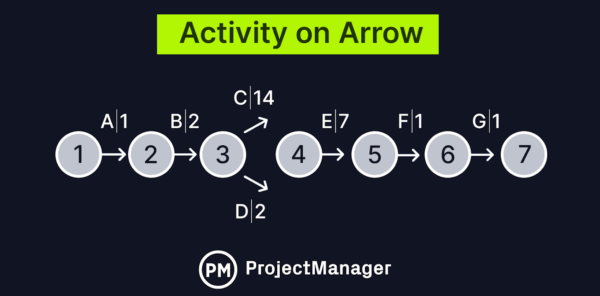

Benefits of This Project Scheduling Technique
ADM can still offer value for teams looking to visualize activity flow in simple, milestone-driven projects. It’s especially helpful in planning environments that emphasize clarity over flexibility.
- Visualizes Project Milestones Clearly: ADM emphasizes key events by representing them as nodes. This helps stakeholders and teams understand when major points in the project must be reached and how activities connect between those milestones.
- Simplifies Task Sequences: By focusing on activity order rather than detailed task attributes, ADM makes it easier to visualize sequential workflows—ideal for projects with predictable, step-by-step execution.
- Facilitates Basic Critical Path Analysis: ADM supports identifying the critical path in a clear and logical format. This makes it useful for teaching scheduling fundamentals or managing smaller projects with limited interdependencies.
Disadvantages of This Project Scheduling Technique
While ADM has historical significance, it comes with several limitations that make it less practical for complex or dynamic project environments.
- Limited Dependency Types: ADM only supports finish-to-start relationships. It lacks the flexibility of methods like PDM, which allow for more nuanced dependency modeling, such as start-to-start or finish-to-finish.
- Can Require Dummy Activities: To represent complex task logic, ADM often needs dummy activities—tasks that take no time but must be shown for logic’s sake. These can clutter diagrams and confuse stakeholders.
- Outdated in Modern Software Tools: Most project management platforms now favor PDM. ADM is rarely supported in newer scheduling tools, which can make implementation cumbersome or limit integration with other planning features.
9. Rolling Wave Planning
Rolling wave planning is a project scheduling technique that involves planning work in greater detail as the project progresses. It’s a form of progressive elaboration, where near-term tasks are defined in detail, while future work is kept at a high level until more information becomes available. This allows project teams to adapt to changing conditions, reduce planning rework and maintain flexibility. Rolling wave planning is especially useful in dynamic or evolving projects where detailed foresight isn’t fully possible at the start.
When to Use This Project Scheduling Technique?
Rolling wave planning is ideal for projects with uncertain scopes, changing requirements, or iterative phases. It’s frequently used in software development, R&D, or innovation-driven projects where details emerge over time. It also benefits large infrastructure projects planned in phases. Use it when early milestones are known, but later activities require refinement. This technique works well in Agile or hybrid project environments, where flexibility and ongoing updates to the project schedule are critical to success.
Benefits of Using This Project Scheduling Technique
Rolling wave planning offers flexibility in uncertain environments. It allows for early execution while giving teams time to develop accurate plans for future tasks.
- Improves Planning Accuracy Over Time: Instead of guessing details too early, rolling wave planning enables more accurate task definitions when information becomes available. This reduces rework and leads to better resource, cost and duration estimates.
- Supports Flexibility in Dynamic Projects: In rapidly changing projects, this method allows teams to adjust timelines and plans without constant major overhauls. It keeps the overall framework stable while adapting to real-time inputs.
- Enables Early Project Execution: Work can begin on well-understood tasks even while future phases are being planned. This shortens lead times and prevents delays while still allowing room for strategic thinking on long-term goals.
Disadvantages of This Project Scheduling Technique
While useful for adaptive planning, rolling wave planning can introduce uncertainty and complexity. It requires strong oversight and ongoing updates to stay effective.
- Lack of Detail Can Confuse Stakeholders: Future work remains vague until later phases, which can lead to misunderstanding or concern among stakeholders who expect a complete plan from the start.
- Demands Ongoing Planning Effort: Rolling wave planning isn’t a one-time activity. It requires repeated planning sessions, timeline adjustments and team alignment as the project moves forward.
- Challenging to Estimate Overall Timeline: Because later phases aren’t fully defined, it can be difficult to accurately estimate the full project duration or forecast long-term resource needs early on.
10. Resource Leveling
Resource leveling is a project scheduling technique used to resolve resource overallocations by adjusting start and end dates based on availability. When resources such as labor, equipment or budget are overbooked or spread too thin, this method balances workloads across the schedule. Tasks may be delayed or extended, but overallocation is avoided. Resource leveling helps project managers create more realistic timelines and avoid burnout or missed deadlines due to resource shortages, making it essential for long-term planning and execution.
When to Use This Project Scheduling Technique?
Resource leveling is most useful when project resources are limited or shared across multiple initiatives. It’s common in construction, IT, consulting, and manufacturing—anywhere resource bottlenecks occur. Use it when team members are overallocated, or when delays are preferable to overworking staff or adding costs. It’s also helpful in portfolio management, where multiple projects compete for the same resources. Leveling is ideal when maintaining quality and avoiding burnout are more important than finishing the project as fast as possible.
Benefits of Using This Project Scheduling Technique
Resource leveling improves schedule realism and helps teams avoid overload. It’s especially beneficial in environments with limited personnel or shared equipment.
- Reduces Resource Overload: By balancing resource demand, this method prevents overuse of individuals or equipment. That reduces the risk of burnout, inefficiency or mistakes caused by excessive multitasking or unrealistic workloads.
- Improves Timeline Accuracy: Leveling aligns project schedules with real-world resource limits, making completion dates more achievable. This leads to better planning, stakeholder trust and fewer last-minute adjustments caused by staffing issues.
- Promotes Sustainable Team Performance: Spreading workload more evenly helps preserve morale, engagement and productivity over time. Teams are less likely to experience stress or turnover due to extended overcommitment.
Disadvantages of This Project Scheduling Technique
While resource leveling solves allocation problems, it can extend project timelines and complicate sequencing. It requires careful planning and may not be ideal when speed is the top priority.
- Can Delay Project Completion: Leveling often requires shifting task start dates to accommodate resource availability, which may push the overall project end date further out.
- Increases Schedule Complexity: Adjusting for resource limits introduces new dependencies or timing gaps that complicate planning. The schedule becomes more difficult to visualize and manage.
- Not Effective in All Project Types: In highly deadline-driven projects, such as regulatory or event-based work, delays may be unacceptable. In such cases, leveling may conflict with time constraints.
How to Implement Project Scheduling Techniques With ProjectManager
ProjectManager implements project scheduling techniques through its multiple project views—Gantt charts, task lists, kanban boards, sheets and calendars—each supporting different aspects of planning while staying fully synchronized. The Gantt chart enables detailed timeline planning with task dependencies and critical path analysis, ideal for applying techniques like the critical path method (CPM) and schedule baselining.
The task list view supports sequential planning and priority setting, while the kanban board helps with agile scheduling and workflow management. The calendar view aids in deadline tracking and milestone planning. Together, these views give teams the flexibility to plan, monitor and adjust schedules using proven techniques, all within one integrated platform.
Schedule Resources and Track Costs
ProjectManager schedules resources and tracks costs effectively using its team page, workload chart and timesheets, all of which work together to align people, tasks and budgets. The team page provides a centralized view of each team member’s assignments, availability and roles, making it easy to assign or update tasks based on skills and capacity.
The workload chart visually displays who is over- or under-allocated, helping managers balance assignments and avoid delays or burnout. Meanwhile, timesheets capture actual hours worked, feeding directly into cost tracking and allowing for real-time comparison against planned budgets. This integrated approach ensures resources are scheduled efficiently and costs are controlled throughout the project lifecycle.
Track Schedules With Real-Time Dashboards and Reports
ProjectManager tracks schedules with real-time dashboards and customizable reports that provide instant, data-driven insights into project progress. The live dashboard automatically pulls updates from tasks, timesheets and resource usage to display key metrics like task completion, overdue items and upcoming deadlines—giving managers immediate visibility into schedule health.
Customizable reports let users drill down into specific aspects of the schedule, such as variance from the baseline, milestone tracking and team performance. Together, these tools enable proactive schedule management, helping teams spot delays early, adjust plans quickly, and keep projects on track.
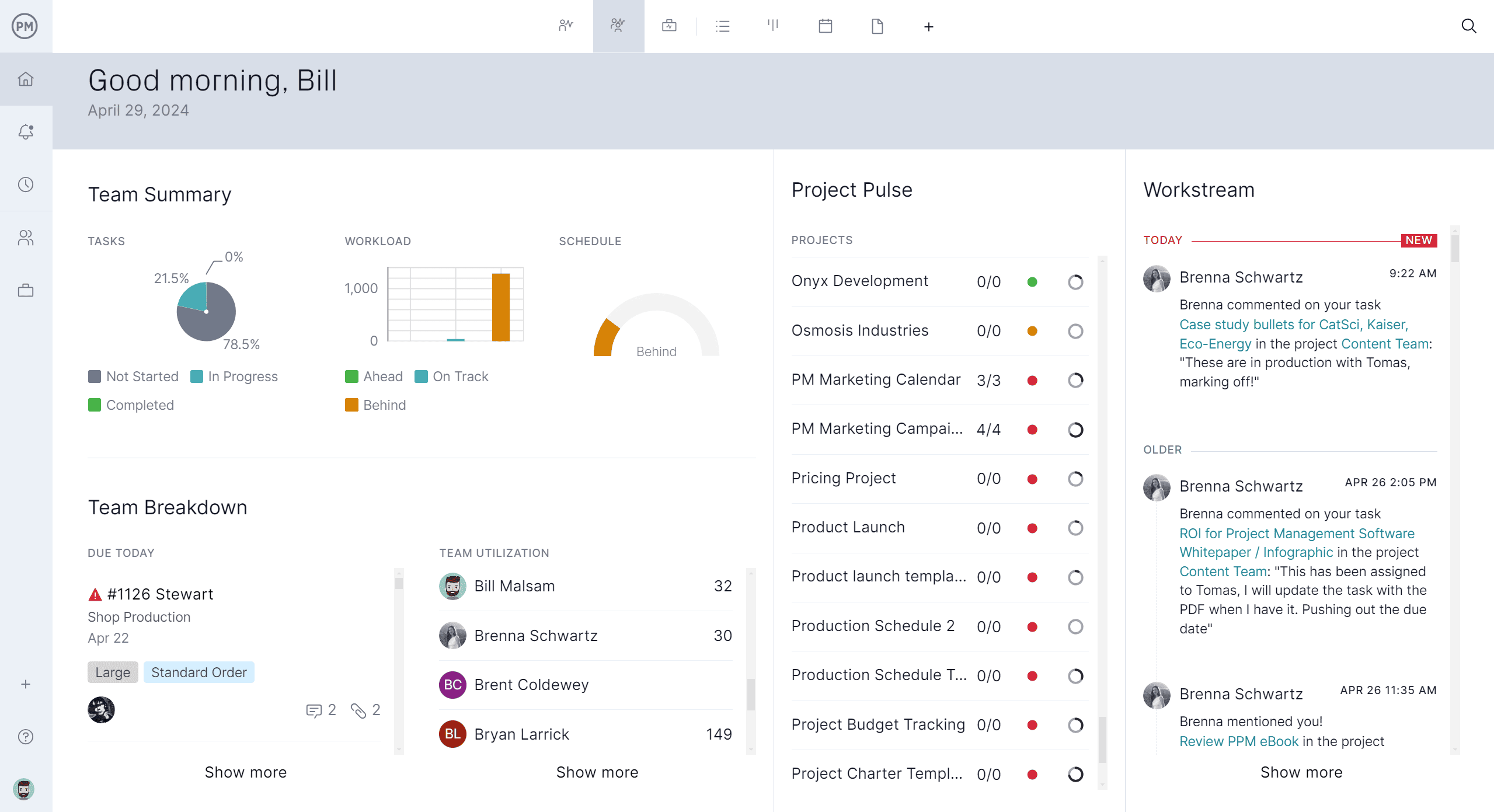

Related Project Scheduling Content
Now that we’ve touched on project scheduling techniques, let’s look at the broader picture. Below are some links to recent articles on resource scheduling, master schedules and more to offer a fuller view of project scheduling.
ProjectManager is online project and portfolio management software that connects teams whether they’re in the office or out in the field. They can share files, comment at the task level and stay updated with email and in-app notifications. Join teams at Avis, Nestle and Siemens who use our software to deliver successful projects. Get started with ProjectManager today for free.





